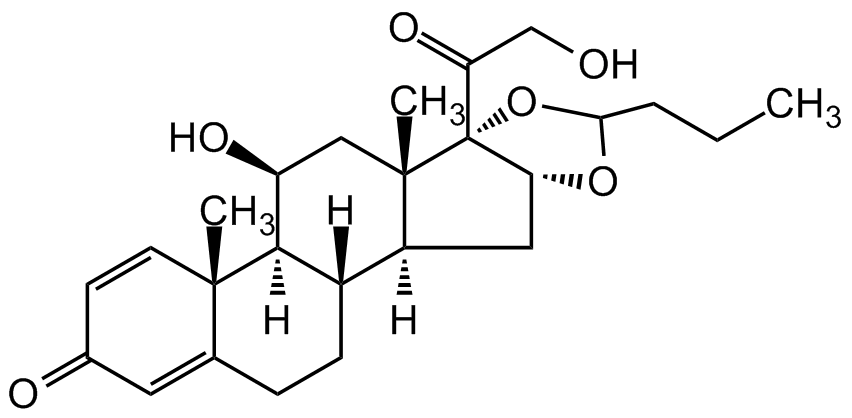Budesonide
| Code | Size | Price |
|---|
| AG-CR1-3753-M010 | 10 mg | £30.00 |
Quantity:
| AG-CR1-3753-M050 | 50 mg | £45.00 |
Quantity:
| AG-CR1-3753-M250 | 250 mg | £130.00 |
Quantity:
Prices exclude any Taxes / VAT
Overview
Regulatory Status: RUO
Shipping:
AMBIENT
Storage:
Short Term: +4°C, Long Term: -20°C
Images
Documents
Further Information
Alternate Names/Synonyms:
16,17-Butylidenebis(oxy)-11,21-dihydroxypregna-1,4-diene-3,20-dione
Appearance:
White to off-white powder.
CAS:
51333-22-3
EClass:
32160000
Form (Short):
liquid
GHS Symbol:
GHS07,GHS08
Handling Advice:
Keep cool and dry.
Hazards:
H312, H315, H332, H361
InChi:
InChI=1S/C25H34O6/c1-4-5-21-30-20-11-17-16-7-6-14-10-15(27)8-9-23(14,2)22(16)18(28)12-24(17,3)25(20,31-21)19(29)13-26/h8-10,16-18,20-22,26,28H,4-7,11-13H2,1-3H3/t16-,17-,18-,20+,21?,22+,23-,24-,25+/m0/s1
InChiKey:
VOVIALXJUBGFJZ-KWVAZRHASA-N
Long Description:
Chemical. CAS: 51333-22-3. Formula: C25H34O6. MW: 430.5. Budesonide is a glucocorticoid and an agonist of glucocorticoid receptors (EC50=45.7pM in a transactivation assay), selective for glucocorticoid over mineralocorticoid receptors. Budesonide is a synthetic anti-inflammatory agent that displays chemopreventive activity. It is used as an anti-inflammatory agent in the treatment of asthma, rhinitis and inflammatory bowel disease and is evaluated in prevention of lung cancer. It prevents formation of lung adenomas and adenocarcinomas in mice following inhalation or oral administration. It also reverses DNA hypomethylation and modulates expression of cancer related genes. Due to its potent activity, as an inhaled glucocorticoid, in reducing airway inflammation, Budesonide has potential as treatment for early COVID-19 infection. In vitro studies have shown that inhaled glucocorticoids can reduce the replication of SARS-CoV-2 in airway epithelial cells and downregulate the expression of ACE2 and TMPRSS2 genes, which are critical for viral cell entry. Budesonide in combination with glycopyrronium and formoterol has been shown to inhibit viral replication of the coronavirus HCoV-229E, by inhibiting receptor expression and/or endosomal function.
MDL:
MFCD00083259
Molecular Formula:
C25H34O6
Molecular Weight:
430.5
Package Type:
Vial
Precautions:
P260, P280, P281, P302+P352, P304+P340, P308+P313, P333+P313
Product Description:
Budesonide is a glucocorticoid and an agonist of glucocorticoid receptors (EC50=45.7pM in a transactivation assay), selective for glucocorticoid over mineralocorticoid receptors. Budesonide is a synthetic anti-inflammatory agent that displays chemopreventive activity. It is used as an anti-inflammatory agent in the treatment of asthma, rhinitis and inflammatory bowel disease and is evaluated in prevention of lung cancer. It prevents formation of lung adenomas and adenocarcinomas in mice following inhalation or oral administration. It also reverses DNA hypomethylation and modulates expression of cancer related genes. Due to its potent activity, as an inhaled glucocorticoid, in reducing airway inflammation, Budesonide has potential as treatment for early COVID-19 infection. In vitro studies have shown that inhaled glucocorticoids can reduce the replication of SARS-CoV-2 in airway epithelial cells and downregulate the expression of ACE2 and TMPRSS2 genes, which are critical for viral cell entry. Budesonide in combination with glycopyrronium and formoterol has been shown to inhibit viral replication of the coronavirus HCoV-229E, by inhibiting receptor expression and/or endosomal function.
Purity:
>98% (HPLC)
Signal word:
Warning
SMILES:
O=C(CO)[C@]12[C@@]3(C)C[C@H](O)[C@@]4([H])[C@@]([C@]3([H])C[C@H]1OC(CCC)O2)([H])CCC5=CC(C=C[C@@]54C)=O
Solubility Chemicals:
Soluble in DMSO (25mg/ml), DMF (20mg/ml) or ethanol (10mg/ml).
Transportation:
Non-hazardous
UNSPSC Category:
Biochemical Reagents
UNSPSC Number:
12352200
Use & Stability:
Stable for at least 2 years after receipt when stored at -20°C.
References
Budesonide. A review of its pharmacological properties and therapeutic efficacy in inflammatory bowel disease: C.M. Spencer & D. McTavish; Drugs 50, 854 (1995) | Transactivation via the human glucocorticoid and mineralocorticoid receptor by therapeutically used steroids in CV-1 cells: A comparison of their glucocorticoid and mineralocorticoid properties: C. Grossmann, et al.; Eur. J. Endocrinol. 151, 397 (2004) | IkappaB kinase-2 inhibitor blocks inflammation in human airway smooth muscle and a rat model of asthma: M.A. Birrell, et al.; Am. J. Respir. Crit. Care Med. 172, 962 (2005) | Modulation by budesonide of DNA methylation and mRNA expression in mouse lung tumors: M.A. Pereira, et al.; Int. J. Cancer 120, 1150 (2006) | Chemoprevention of pulmonary carcinogenesis by aerosolized budesonide in female A/J mice: L.W. Wattenberg, et al.; Cancer Res. 57, 5489 (2007) | Design and synthesis of long acting inhaled corticosteroids for the treatment of asthma: D.S. Millan, et al.; Bioorg. Med. Chem. Lett. 21, 5826 (2011) | Inhibitory effects of glycopyrronium, formoterol, and budesonide on coronavirus HCoV-229E replication and cytokine production by primary cultures of human nasal and tracheal epithelial cells: M. Yamaya, et al.; Respir. Investig. 58, 155 (2020) | Inhaled budesonide in the treatment of early COVID-19 (STOIC): a phase 2, open-label, randomised controlled trial: S. Ramakrishnan, et al.; Lancet Respir. Med. (Epub ahead of print) (2021) | Early treatment with inhaled budesonide to prevent clinical deterioration in patients with COVID-19: A. Agusti, et al.; Lancet Repir. Med. (Epub ahead of print) (2021)



